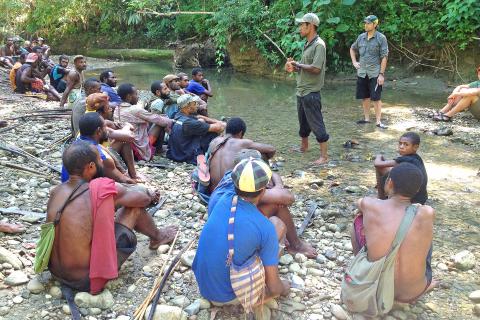A 6,000-year-old skull found in Papua New Guinea is likely the world’s oldest-known tsunami victim, experts said yesterday after a new analysis of the area it was found in.
The partially preserved Aitape skull was discovered in 1929 by Australian geologist Paul Hossfeld, 12km inland from the northern coast of Papua New Guinea.
It was long thought to belong to Homo erectus (upright man), an extinct species thought to be an ancestor of the modern human that died out about 140,000 years ago.

Photo: AFP / UNIVERSITY OF NEW SOUTH WALES / Ethan COCHRANE
However, more recent radiocarbon dating estimated it was closer to 6,000 years old, making it a member of our own species — Homo sapiens. At that time, sea levels were higher and the area would have been near the coast.
An international team led by the University of New South Wales (UNSW) returned to the site to collect the same geological deposits observed by Hossfeld.
Back in the lab, they studied details of the sediment including its grain size and geochemical composition, which can help identify a tsunami inundation.
They also identified a range of microscopic organisms from the ocean in the sediment, similar to those found in soil after a devastating tsunami hit the region in 1998.
“We have discovered that the place where the Aitape skull was unearthed was a coastal lagoon that was inundated by a large tsunami about 6,000 years ago,” study author and UNSW scientist James Goff said. “It was similar to the one that struck nearby with such devastating effect in 1998, killing more than 2,000 people.”
“We conclude that this person who died there so long ago is probably the oldest-known tsunami victim in the world,” Goff said.
The conclusions, aided by researchers from the US, France, New Zealand and Papua New Guinea, were published in the journal PLOS ONE.
Goff, an authority on tsunamis, said while the bones of the skull had been well-studied previously, little attention had been paid to the sediments where they were unearthed.
“The geological similarities between these sediments and the sediments laid down during the 1998 tsunami made us realize that human populations in this area have been affected by these massive inundations for thousands of years,” he said.
“After considering a range of possible scenarios, we believe that, on the balance of the evidence, the individual was either killed directly in the tsunami, or was buried just before it hit and the remains were redeposited,” Goff added.
Following the 1998 tsunami, which penetrated up to 5km inland, attempts to retrieve victims were called off after a week because crocodiles were feeding on the corpses, leading to their dismemberment.
This may also explain why the skull of the person who died 6,000 years ago was found on its own, without any other bones, the researchers said.
Attention has been drawn to the effect of tsunamis in recent decades, particularly following those in Indonesia in 2004 and Japan in 2011, which killed about 230,000 and 16,000 people respectively.
However, research in the Pacific has shown that throughout history and prehistory, the region has seen repeated catastrophic tsunamis that have caused death, abandonment of settlements, breakdown of trading routes and even war, the study said.

THE ‘MONSTER’: The Philippines on Saturday sent a vessel to confront a 12,000-tonne Chinese ship that had entered its exclusive economic zone The Philippines yesterday said it deployed a coast guard ship to challenge Chinese patrol boats attempting to “alter the existing status quo” of the disputed South China Sea. Philippine Coast Guard spokesman Commodore Jay Tarriela said Chinese patrol ships had this year come as close as 60 nautical miles (111km) west of the main Philippine island of Luzon. “Their goal is to normalize such deployments, and if these actions go unnoticed and unchallenged, it will enable them to alter the existing status quo,” he said in a statement. He later told reporters that Manila had deployed a coast guard ship to the area

A group of Uyghur men who were detained in Thailand more than one decade ago said that the Thai government is preparing to deport them to China, alarming activists and family members who say the men are at risk of abuse and torture if they are sent back. Forty-three Uyghur men held in Bangkok made a public appeal to halt what they called an imminent threat of deportation. “We could be imprisoned and we might even lose our lives,” the letter said. “We urgently appeal to all international organizations and countries concerned with human rights to intervene immediately to save us from

RISING TENSIONS: The nations’ three leaders discussed China’s ‘dangerous and unlawful behavior in the South China Sea,’ and agreed on the importance of continued coordination Japan, the Philippines and the US vowed to further deepen cooperation under a trilateral arrangement in the face of rising tensions in Asia’s waters, the three nations said following a call among their leaders. Japanese Prime Minister Shigeru Ishiba, Philippine President Ferdinand Marcos Jr and outgoing US President Joe Biden met via videoconference on Monday morning. Marcos’ communications office said the leaders “agreed to enhance and deepen economic, maritime and technology cooperation.” The call followed a first-of-its-kind summit meeting of Marcos, Biden and then-Japanese prime minister Fumio Kishida in Washington in April last year that led to a vow to uphold international

US president-elect Donald Trump is not typically known for his calm or reserve, but in a craftsman’s workshop in rural China he sits in divine contemplation. Cross-legged with his eyes half-closed in a pose evoking the Buddha, this porcelain version of the divisive US leader-in-waiting is the work of designer and sculptor Hong Jinshi (洪金世). The Zen-like figures — which Hong sells for between 999 and 20,000 yuan (US$136 to US$2,728) depending on their size — first went viral in 2021 on the e-commerce platform Taobao, attracting national headlines. Ahead of the real-estate magnate’s inauguration for a second term on Monday next week,